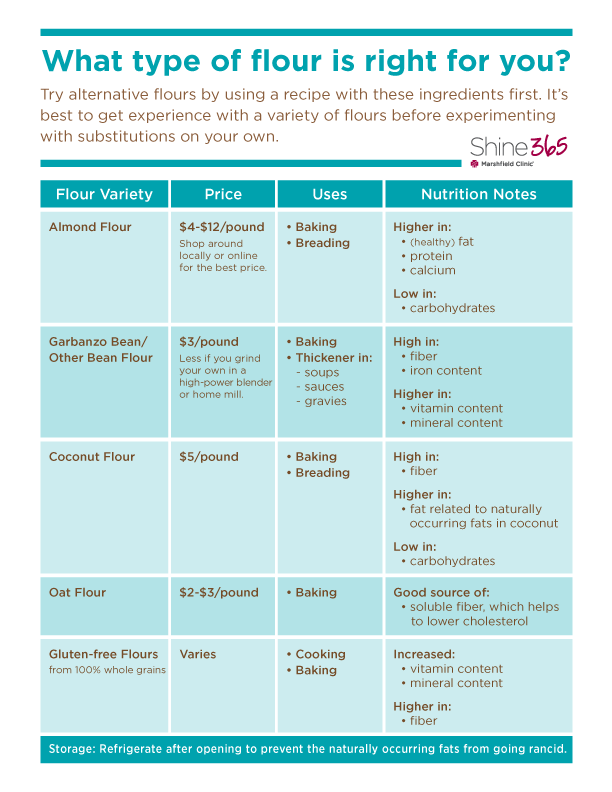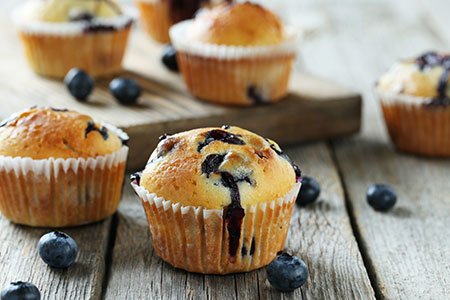Have you been fiddling with different flours? Are you curious about your options and what to try?
People with celiac disease need to eliminate wheat and gluten, said Shelly Wildenberg, a registered dietitian with Marshfield Clinic. “This is the most common reason for using (alternative flours) and experimenting with them,” she said. “However, these flours can be beneficial for anyone to use in addition to wheat flours.”
Flour types
Flours like almond, garbanzo bean, coconut and oat provide variety, produce different textures and flavors and offer nutritional benefits: often increased fiber and high vitamin and mineral content.
“In general, it’s healthy to strive to eat beans three times per week. Bean flours can help people achieve this,” Wildenberg said. “Beans are one of the highest fiber foods, and people should be looking for ways to add more beans to their diets.”
Beans help promote regularity and the high soluble fiber content is known for lowering cholesterol, she said.
Garbanzo bean flour (also known as chickpea) is Wildenberg’s favorite alternative, “because it allows you to squeeze beans into muffins and other baked goods. People will never know it’s there.”
Gluten-free flours can help with a whole foods approach to eating, Wildenberg said, which has been associated with protection from chronic disease because of the high nutritional benefits.
One-hundred percent whole wheat flours are nutritious as well, because of their minimal processing.
When choosing alternative flours, Wildenberg recommends using as much 100 percent whole-grain flour as possible.
Highly processed foods have contributed to the weight epidemic in our country,” she said.
With processing, the grain is stripped of the nutritious qualities and left with mostly the starch. Unfortunately, some gluten-free flours also are processed, removing nutrition.
“If the first ingredient of a gluten-free flour is white rice, cornstarch, tapioca starch or potato starch, that should be a red flag for processing,” she said. The first ingredient should be the whole food. Gluten-free or not, watch for the first ingredient to be whole grain, whole stoneground grain, brown rice or oats.
Approach gluten-free diets with caution if you do not have a medical diagnosis or medical reason to make the switch, Wildenberg warned.
Try this recipe
If you want to try these alternative flours, find a recipe using these ingredients first. Get experience with a variety of flours before experimenting with substitutions on your own, Wildenberg said. She recommends this recipe to get you started.
Blueberry Chickpea Flour Muffins

Servings: 6
Time: 15-20 mins
Ingredients
- 1 cup chickpea flour
- 1/4 cup brown sugar
- 1 teaspoon baking powder
- 1/2 teaspoon baking soda
- 1/2 teaspoon cinnamon
- 1/4 teaspoon salt
- 1 large egg, lightly beaten
- 1/2 cup mashed banana (about one banana)
- 3 tablespoons oil
- 1/2 cup blueberries (fresh or frozen)
Instructions
Preheat oven to 375F and lightly grease or line a muffin tin with liners.
In a medium bowl, combine all dry ingredients (chickpea flour to salt) and whisk together.
In a large bowl, combine egg, banana and oil.
Pour dry ingredients into wet and stir until moistened.
Fold in the blueberries.
Pour batter into 6 muffin cups and bake for 15-20 minutes, until tops are set and browned a bit and when applying a bit of pressure on the top – doesn’t make a dent.
Let cool on a wire rack.
Nutritional information
Each muffin contains about 192 calories, 24 g carbs, 9 g fat, 5 g protein, 280 mg sodium and 14 g sugar.
Source: Adapted from jacksbalancingact.com
Download and print recipe





Leave a Reply